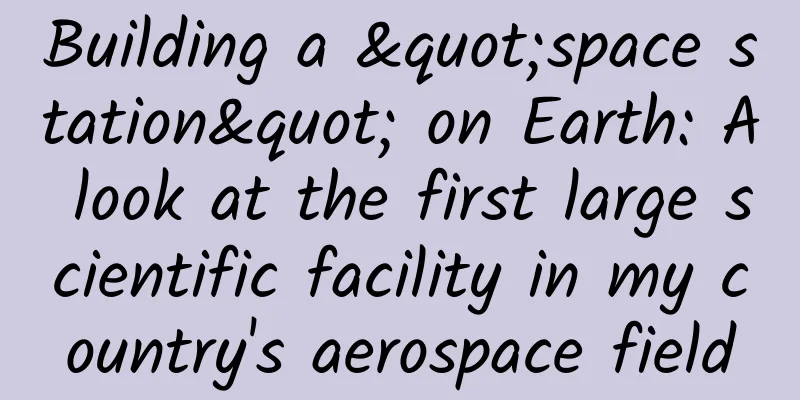Building a "space station" on Earth: A look at the first large scientific facility in my country's aerospace field

|
In an orbit more than 400 kilometers above the earth, the Chinese space station travels in the sky, becoming one of the important milestones in my country's space industry. Looking far into the northeast corner of the motherland, a ground simulation device for space environment known as the "ground space station" was officially completed not long ago and entered the trial operation stage. Many indicators have reached the world's leading level. As the first large scientific facility in my country's aerospace field, the "Ground Space Station" is the world's first comprehensive research facility that integrates the most environmental factors and can realize multi-scale and cross-scale environmental effects research. It will contribute wisdom and strength to the development of my country's aerospace industry and human space exploration. Dream come true: Building a "space station" on Earth The space environment is harsh and complex, which not only tests the reliability of spacecraft, but also challenges the health and safety of astronauts. How to enhance the ability of space exploration is a difficult problem that needs to be solved urgently. "If we want to fly farther, stay longer and explore more carefully, we must understand the space environment better." Li Liyi, executive deputy commander of the space environment ground simulation device and dean of the Institute of Space Environment and Material Science of Harbin Institute of Technology, said that the "ground-based space station" is to build a basic scientific research platform on Earth that is similar to the real space environment, which is equivalent to building a "space station" on Earth. The "ground space station" is located in the Science and Technology Innovation City of Harbin New Area, Heilongjiang Province, and is built by Harbin Institute of Technology and China Aerospace Science and Technology Corporation. In the construction park, there are four experimental buildings, one large and three small. The "one large" is the space comprehensive environment experimental building, and the "three small" are the space plasma science experimental building, the space magnetic environment science experimental building and the animal culture room. Researchers at Harbin Institute of Technology's space environment ground simulation device debug the space life science subsystem (photo taken on April 6). Xinhua News Agency reporter Wang Song According to the design plan, the "ground space station" can simulate nine major space environmental factors, including vacuum, high and low temperatures, charged particles, electromagnetic radiation, space dust, plasma, weak magnetic fields, neutral gases, and microgravity, and can explain the influence and mechanism of the space environment on materials, devices, systems, and life forms. Compared with moving experimental instruments and equipment into space, the "ground space station" can not only save costs and reduce safety hazards, but also set specific environmental factors according to scientific problems and engineering needs, and conduct repeated verifications without being restricted by time and space, thereby creating safer and more convenient experimental conditions and scientific research methods. As the circular arch slowly moved, the moon dust cabin came into view. This was the "simulated moon" experimental cabin. In a space more than one person high, a one-meter square platform shone with silver light, and the searchlights and radiation sources suspended on the top were of different shapes. Team member Sun Chengyue said that the lunar dust capsule has mastered many key technologies, including the integration of multi-source irradiation charging equipment, uniform scattering of tiny dust, and optical in-situ online detection of strong electrostatic environments. It will provide a scientific research platform for major aerospace projects such as my country's lunar exploration, lunar base construction, and manned space flight. This is the lunar dust chamber of Harbin Institute of Technology's space environment ground simulation device (photo taken on April 6). Xinhua News Agency reporter Wang Song "In the future, many experiments that require reaching space can be completed on the ground." Yan Jihong, deputy director of the Institute of Space Environment and Materials Science at Harbin Institute of Technology, said that this is what scientists dream of. Tackling tough problems: warming up the “cold bench” Talking about the origin of the "ground space station", Li Liyi said that the space environment leads to frequent aerospace failures, which has become the key to restricting the long life and high-reliability operation of spacecraft. As early as 2005, Harbin Institute of Technology began to form a team in conjunction with China Aerospace Science and Technology Corporation to conduct research and analysis on the research platform conditions for basic scientific issues on the interaction between space environment and matter. "Scientific and technological research is aimed at the most pressing problems." E Peng, deputy director of the Institute of Space Environment and Material Science at Harbin Institute of Technology, said that the construction of large scientific facilities plays an important supporting role in many basic frontier research and strategic high-tech research. This is the particle acceleration system of Harbin Institute of Technology's space environment ground simulation device (photo taken on April 6). Xinhua News Agency reporter Wang Song After repeated demonstrations and prudent decisions by scientists in related fields and relevant departments, the "Space Environment Ground Simulation Device" project was approved in September 2015; In January 2017, its feasibility study was approved, and in July of the same year, the preliminary design of the device was approved, and construction began at the end of the year; In September 2019, the Institute of Space Environment and Material Science of Harbin Institute of Technology was established. The team has grown from a few people at the beginning of its establishment to more than 100 people, covering multiple disciplines such as physics, materials, electromechanics, electrical engineering, chemical engineering, aerospace, and life sciences. In February 2023, Harbin Institute of Technology's Space Environment and Material Interaction Frontier Science Center was approved for construction... Unlike other scientific research projects and infrastructure, large scientific facilities are both a scientific project and an engineering project, with the dual characteristics of scientific research and engineering construction. They are technically difficult, have long cycles, and high risks, and there is almost no experience to draw on. As an important part of the "ground space station", the goal of the zero-magnetic space environment is to build a near-zero-magnetic space that shields the interference of the external magnetic field. Under the guidance of her mentor, Sun Zhiyin, a member of the "post-90s" team, innovatively proposed a "nesting doll" magnetic shielding design when she was studying for her doctorate. Researchers at Harbin Institute of Technology's space environment ground simulation device demonstrate the space magnetic environment simulation and research system (photo taken on April 6). Xinhua News Agency reporter Wang Song Liu Jianli, chief designer of the ion accelerator system of the "Ground Space Station", recalled that since a large number of equipment did not have mature products, the team had to start from scratch. Design, processing, installation, commissioning, data analysis... every link required "120% of the energy" to be invested. "As a scientific research 'national team', we cannot only consider what I can do and what I can do, but also what we should do and what we need to do." "Cross the river by feeling the stones, and move the stones wherever there are stones."... Team members admitted that large scientific facilities usually require a team of three to four hundred people, but the "ground space station" can be completed by about a hundred people. It is normal not to rest on weekends and holidays and to work more than ten hours a day. Many times "one person does the work of two people." "Why is the 'ground-based space station' possible? The key lies in independent innovation and the determination to 'bite the hard bones with steel teeth'." Han Jiecai, president of Harbin Institute of Technology and chief designer of the ground-based space environment simulation device, said that the school has cooperated with many cooperative units to continuously tackle key problems, and scientific research exploration has always been carried out throughout the construction to achieve synchronous advancement. Outlook: Opening a new chapter in scientific and technological exchanges and cooperation Harbin is lush and green in summer. Yu Yuanyang, a post-95 doctoral student from the Gravitational Center of the School of Physics at Huazhong University of Science and Technology, sits in front of the zero-magnetic device and carefully observes the experimental data on the computer screen. He will conduct a one-month gravitational wave detection experiment here. "The key components we use have very weak magnetism, and only in a specific zero-magnetic environment can we obtain more accurate measurement results." Yu Yuanyang said, "The ground-based space station" is a national weapon and a scientific research tool that will help promote the output of a large number of scientific research results. At present, scientists at home and abroad are competing to apply to enter the "ground space station" to conduct scientific experiments. More than 110 institutions have signed user agreements, covering more than 30 countries and regions. Large scientific facilities carry the good wishes of mankind to explore the unknown world, and attract a group of young scientific and technological workers who come from many universities and research institutes, and combine their growth and development more closely with the needs of national development. This year, Nie Qiuyue, who was born in the 1980s, celebrates her tenth year teaching at Harbin Institute of Technology. In 2014, after completing her postdoctoral work at Tsinghua University, she resolutely chose to go north to participate in the development of space plasma environment simulation and research systems. This is the space plasma environment simulation and research system of Harbin Institute of Technology's space environment ground simulation device (photo taken on April 6). Xinhua News Agency reporter Wang Song "Large scientific facilities will become a new source of ideas for seizing the commanding heights of scientific and technological competition." Jin Chenggang, who moved from a university in the south to Harbin Institute of Technology, said that from aerospace electronic component inspection to gravitational wave detection, from agricultural breeding to life science experiments, more and more scientific research will be carried out here, and more and more high-level scientific research talents will gather here. At present, the spillover effect of the construction of the "ground space station" has already emerged, and it has obtained more than 80 international and domestic invention patents. It will play an important role in brain science, life and health, high-end instruments, irradiation breeding and other fields. This is the Mars dust chamber of Harbin Institute of Technology's space environment ground simulation device (photo taken on April 6). Xinhua News Agency reporter Wang Song Industry insiders admit that driven by a new round of scientific and technological revolution and industrial transformation, the "ground space station" is expected to solve bottleneck problems in the integrated design of aerospace products, modular manufacturing, and adaptability to the space environment, and drive the development of emerging industries such as satellite manufacturing, electronic information, artificial intelligence, new materials, and biomedicine. Innovation is endless, and innovation means pursuing the future. Xiong Sihao, secretary of the Party Committee of Harbin Institute of Technology, said that the school will strive to build the "ground space station" into an advanced technology research and engineering application platform, and make greater contributions to the construction of a strong country in science and technology and the exploration of unknown mysteries. Reporter: Yang Siqi Video reporter: Yang Siqi, Wang Dayu Poster design: Chang Qingtan Editors: Li Huan, Hao Jing, Li An, Wu Jinfu, Cheng Hao Co-ordinators: Wang Jie, Fang Sixian |
<<: How big are the health risks of using plastic bottles?
>>: Don’t blame your husband for having a yellow pillow, he produces half more oil than you!
Recommend
How much does it cost to customize the Dehong textbook mini program? What is the price quote for the customized Dehong textbook mini program?
The mini program provides convenience for publici...
Whether it is bidding or information flow, you can spend more money, but it must not be ineffective
If we talk about the two most popular traffic cha...
Wanshi E-commerce · Douyin Store Natural Flow Online Practical Course [2022 Edition], teach you how to run a Douyin store from scratch
Wanshi E-commerce · Douyin Store Natural Flow Onl...
How can your app win in the competition if it cannot achieve intelligent operation?
The so-called intelligent operation focuses on ac...
Seven training camp short video driving and monetization compulsory course video
Seven training camp short video driving and monet...
The Starship launch failed, but the next era of spaceflight is coming
Recently, an event that is amazing in the entire ...
Sony Walkman ZX300A delivers the sound of nature that will move you
Music is an art of expressing emotions. No matter...
What new product operators must know about operational planning!
As a programmer who switched to a product manager...
Case analysis: Techniques for attracting new customers through paid content!
Since 2016, the concept of "micro-course&quo...
It's been said that there has been no lag for 18 months, so why do you still think iOS is smoother than Android?
You may be a loyal fan of iOS or Android, and I b...
How much does it cost to attract investment in the Nanchang Mall Mini Program? What is the investment price of Nanchang Mall Mini Program?
The advantages of WeChat mini program investment ...
New energy stocks will be released by the end of July to allow foreign investment
On June 28, 2018, China's Ministry of Commerc...
Review of 4 private domain traffic live broadcast cases
All brands are paying close attention to private ...









